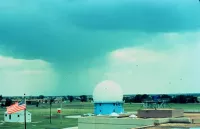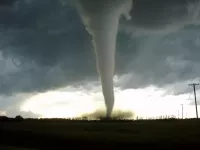The National Weather Service (NWS) is a US federal agency responsible for providing weather forecasts, hazardous weather warnings, and related information to protect life and property. As part of the National Oceanic and Atmospheric Administration (NOAA) and the Department of Commerce, it's headquartered in Silver Spring, Maryland. Formerly known as the United States Weather Bureau (1891-1970), the NWS plays a vital role in public safety by monitoring weather patterns and disseminating crucial weather-related data to organizations and the general public.
1937: First Weather Bureau radiosonde launched
In 1937, the first Weather Bureau radiosonde was launched in Massachusetts, leading to a shift from aircraft observation to radiosondes within two years.
1938: Tornado warnings disseminated to emergency personnel
Until 1938, the Weather Bureau prohibited the use of the word "tornado" in weather products. In 1938, the Bureau began disseminating tornado warnings exclusively to emergency management personnel.
1940: Weather Bureau moved to Department of Commerce
In 1940, the Weather Bureau was moved to the Department of Commerce.
1941: First female statistician hired
In 1941, Margaret Smagorinsky (née Knoepfel) was hired as the Weather Bureau's first female statistician.
September 23, 1946: First River Forecast Center founded
On September 23, 1946, the first River Forecast Center (RFC) was founded.
1948: Pioneering of tornado forecasts
In 1948, Air Force Capt. Robert C. Miller and Major Ernest Fawbush pioneered tornado forecasts.
July 12, 1950: Ban on public tornado alerts lifted
On July 12, 1950, Bureau chief Francis W. Reichelderfer officially lifted the agency's ban on public tornado alerts.
March 1952: First experimental public tornado forecasts issued
In March 1952, the Bureau issued its first experimental public tornado forecasts, after facing criticism for refusing to provide such warnings.
1957: Bureau began using radars for short-term forecasting
In 1957, the Bureau began using radars for short-term forecasting of local storms and hydrological events, using modified versions of those used by Navy aircraft to create the WSR-57.
August 1966: Weather Bureau became part of ESSA
In August 1966, the Weather Bureau became part of the Environmental Science Services Administration (ESSA) when that agency was formed.
October 1, 1970: ESSA renamed NOAA, Weather Bureau becomes NWS
On October 1, 1970, the Environmental Science Services Administration (ESSA) was renamed the National Oceanic and Atmospheric Administration (NOAA), and the Weather Bureau became the National Weather Service.
1970: Name Change to National Weather Service
In 1970, the United States Weather Bureau adopted its current name, the National Weather Service (NWS).
1974: Upgrades to WSR-74 models began
Beginning in 1974, some of the WSR-57 radars were upgraded to WSR-74 models.
1983: Proposal to auction off weather satellites
In 1983, NOAA administrator John V. Byrne proposed to auction off all of the weather satellites and outsource weather observation stations but the proposal failed.
1983: Proposal to sell weather satellites met with opposition
In 1983, the Reagan administration proposed to sell all weather satellites, but the proposal failed due to public and congressional opposition.
1988: NEXRAD deployment begins
The deployment of NEXRAD (Next Generation Radar) system to improve detection and warning time of severe local storms began in 1988.
1997: Full deployment of WSR-88D Doppler radar system
By 1997, the WSR-88D Doppler weather radar system, also called NEXRAD, was fully deployed throughout the majority of the United States.
1997: NEXRAD deployment completed
In 1997, NEXRAD (Next Generation Radar) replaced the WSR-57 and WSR-74 systems.
October 2000: Establishment of NOAA Weather Wire Service
In October 2000, the NOAA Weather Wire Service (NWWS) was established to provide timely delivery of weather information.
2005: National Weather Service Duties Act of 2005 introduced
In 2005, Pennsylvania Senator Rick Santorum introduced the National Weather Service Duties Act of 2005, which would have restricted the free distribution of weather data, but the bill died in committee.
September 30, 2007: Warnings issued using geopolitical boundaries until this date
Until September 30, 2007, local offices of the National Weather Service issued warnings using geopolitical boundaries.
October 1, 2007: Implementation of storm-based warnings
On October 1, 2007, storm-based warnings were implemented, delineating alerts by polygonal shapes based on projected storm paths.
April 2012: Impact Based Warning system introduced
In April 2012, the NWS introduced the Impact Based Warning system at its Weather Forecast Offices.
2015: Expansion of Impact Based Warning system
By the spring of 2015, the Impact Based Warning system would expand to 80 Weather Forecast Offices.
2016: National Weather Service organization
As of 2016, the National Weather Service was organized.
2016: Criticism of NWS forecast accuracy
In 2016, Critics claimed that NWS forecasts were not as accurate as they could be, resulting in inaccurate daily weather forecasts.
2016: Increased computational power of supercomputers
In 2016, the NWS significantly increased the computational power of its supercomputers, spending $44 million on two new supercomputers from Cray and IBM.
2016: NOAA Announces Development of The Next Generation Global Prediction System
In 2016, the National Oceanic and Atmospheric Administration (NOAA) announced its plan to develop The Next Generation Global Prediction System.
2025: Layoffs and privatization efforts at NOAA
During the federal mass layoffs in 2025, probationary employees received notices due to their skills not fitting the agency’s current needs. The companies chosen to assist NOAA had ties to Trump officials.
2025: Impact of NOAA Cuts Under Trump Administration
In 2025, the National Weather Service was deeply affected by cuts to NOAA under the second presidency of Donald Trump, including staff layoffs and contract cancellations.
Mentioned in this timeline

Radar is a radiodetermination system using radio waves to detect...

Weather radar is a crucial tool for detecting precipitation assessing...

A tornado is a rotating column of air connecting the...
Massachusetts officially the Commonwealth of Massachusetts is a state located...

St Louis is an independent city located in Missouri near...

Richard John Santorum Sr is an American politician attorney author...
Trending

6 months ago Ariana Grande mourns the loss of her grandmother Marjorie 'Nonna' Grande at 99.

1 month ago Warriors' Commitment Questioned After Loss; Green, Butler Criticize Teammates; Curry's Reaction?

18 days ago Kyshawn George's Status Uncertain: Toe Injury Puts Pacers Player's Game in Doubt

6 months ago LaVar Ball Urges Clippers to Trade for LaMelo; Sends Message to NBA.

20 days ago Earthquake Rattles Northern California on Thanksgiving: Santa Rosa Area Sees 3.3 Magnitude

Jaylen Wells is an American professional basketball player currently with the Memphis Grizzlies in the NBA He transitioned to the...
Popular

Candace Owens is an American conservative political commentator and author...

Tucker Carlson is an American conservative political commentator known for...

XXXTentacion born Jahseh Dwayne Ricardo Onfroy was a controversial yet...

Ben Shapiro is a prominent American conservative political commentator media...

Kashyap Pramod Patel is an American lawyer who became the...

William Franklin Graham III commonly known as Franklin Graham is...